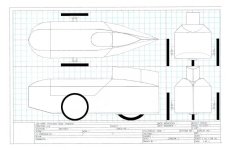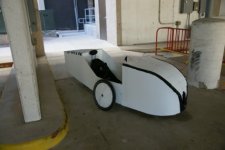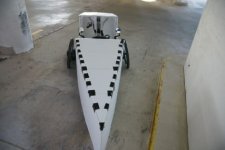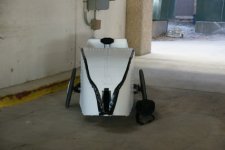The Toecutter
100 kW
- Joined
- Feb 8, 2015
- Messages
- 1,312
Here's an old drawing. This body is mostly finished but not yet mounted.
I still have to make the lid piece. It has a hinge structure at the front that it slides into, but is not permanently affixed. It hinges forward, and removing it will allow me to fit the bike in and out of my 30 inch doorway by tilting it 90 degrees and standing with my body occupying the empty space that the lid piece would otherwise be covering, push the front through the door, then tilt it back at the turtle deck section. Velcro strips, hooks, and teflon straps hold the lid piece onto the body. If I get into a wreck, it is designed so that I won't become impaled or cut up by the lid piece; it will fold/collapse instead. It will be getting foam padding around the edges facing the rider as well. Attached to this post is a rendering. Each blue square in the graph is 100 mm and it was drawn to 1/10th scale(1 cm with a ruler = 10 cm actual). Frontal area comes out to 0.60 m^2 rounded down to the 2nd decimal place.
This drawing also depicts it without mirrors, lights, signals, canopy with wind screen, NACA ducts for cooling, wheel pants, and vinyl wrapping(for coloring and uv protection), all of which will be features of the finished product, and depending on placement, as a combined total may or may not increase frontal area and/or drag significantly. I'm hoping for a drag coefficient of 0.25 before the canopy and wheel pants are installed.
I still have to make the lid piece. It has a hinge structure at the front that it slides into, but is not permanently affixed. It hinges forward, and removing it will allow me to fit the bike in and out of my 30 inch doorway by tilting it 90 degrees and standing with my body occupying the empty space that the lid piece would otherwise be covering, push the front through the door, then tilt it back at the turtle deck section. Velcro strips, hooks, and teflon straps hold the lid piece onto the body. If I get into a wreck, it is designed so that I won't become impaled or cut up by the lid piece; it will fold/collapse instead. It will be getting foam padding around the edges facing the rider as well. Attached to this post is a rendering. Each blue square in the graph is 100 mm and it was drawn to 1/10th scale(1 cm with a ruler = 10 cm actual). Frontal area comes out to 0.60 m^2 rounded down to the 2nd decimal place.
This drawing also depicts it without mirrors, lights, signals, canopy with wind screen, NACA ducts for cooling, wheel pants, and vinyl wrapping(for coloring and uv protection), all of which will be features of the finished product, and depending on placement, as a combined total may or may not increase frontal area and/or drag significantly. I'm hoping for a drag coefficient of 0.25 before the canopy and wheel pants are installed.





